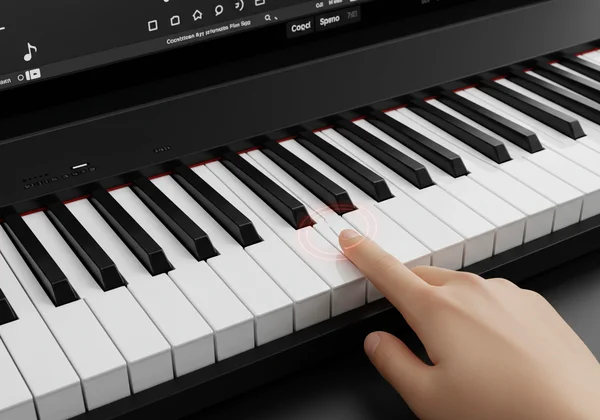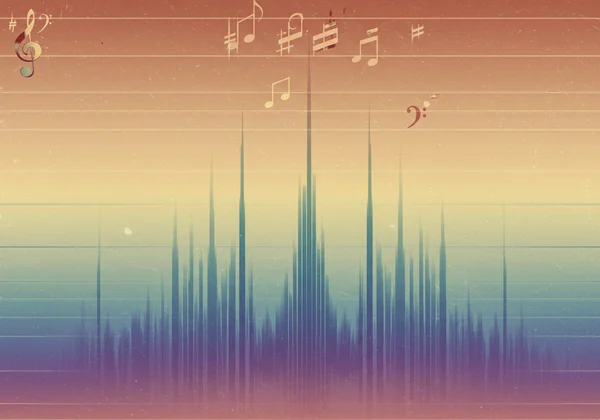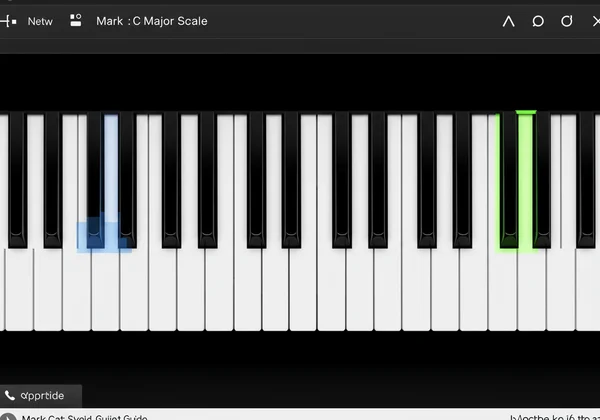Understanding Piano Keyboard Notes: A Virtual Piano Guide
Does a piano keyboard look daunting with its rows of white and black keys? It might seem like a secret language at first. But what if you could crack that code today, right from your computer, for free? This guide is your key to unlocking the secrets of the piano. How can I play piano on my computer? With a powerful virtual piano, you can start your musical journey instantly, turning confusion into confidence.
At our platform, we believe everyone deserves to experience the joy of making music. That's why we've created a completely free, browser-based online piano keyboard that requires no downloads or sign-ups. It’s time to stop wondering and start playing. Let’s dive into the fundamentals of piano keyboard notes and get your fingers moving on our free virtual piano today.

Exploring Piano Keyboard Notes & Layout
The first step to playing the piano is understanding its layout. At first glance, it might look random, but there's a simple, repeating pattern that, once you see it, you can't unsee. This pattern is your map to navigating all 88 keys of a standard piano, and it's just as easy to see on an online piano keyboard.
White Keys & Black Keys: The Repeating Pattern Revealed
Look closely at the black keys. You’ll notice they are arranged in groups of twos and threes. This is the secret to the entire keyboard layout. The seven white keys (A, B, C, D, E, F, G) are arranged around these black key groups. This 12-note pattern (7 white keys + 5 black keys) repeats all the way up and down the keyboard.
Think of the group of two black keys as your landmark. The white key immediately to the left of this group is always a C. Once you can find any C, you can find every other note on the piano just by following the musical alphabet. It’s a simple system that makes learning the piano keys explained much easier than you think.
Finding Middle C: Your Essential Anchor Point
Among all the Cs on the piano, one is special: Middle C. This note is your central command, the most important anchor point for any beginner. As its name suggests, it’s located near the middle of the keyboard. To find it, look for the group of two black keys closest to the center of your piano or screen. The white key just to the left is your central C.
This note is the dividing line between the notes you’ll typically play with your right hand (higher notes) and those you’ll play with your left hand (lower notes). Mastering the location of Middle C gives you a constant reference point, making it easier to find other notes as you learn. Go ahead and explore the keyboard now and see how quickly you can spot it!

How Our Virtual Piano Helps You Identify Notes with Ease
Memorizing notes can be challenging, but technology gives us a huge advantage. Our virtual piano has a built-in note display feature. With a single click, you can make the names of all the keys appear right on the keyboard. You can choose to see standard note names (C, D, E) or even Solfège (Do, Re, Mi), which is perfect for ear training.
This is one of the most powerful online piano features for a beginner. Instead of guessing, you get instant visual feedback, which accelerates your learning process. You can toggle the labels on and off to test your knowledge, turning practice into an interactive game.
What Are Piano Octaves? Understanding Pitch Ranges
You may have noticed that the note names C, D, E, etc., repeat across the keyboard. Each time this sequence of seven white keys repeats, it forms a new octave. Understanding what are piano octaves is key to understanding the full expressive power of the piano, from the lowest rumbles to the highest, sparkling tones.
The Repeating Cycle: Why Notes Repeat Across Octaves
An octave is the interval between one musical note and another with double or half its frequency. To put it simply, the C in one octave sounds like a higher-pitched version of the C in the octave below it. They are the same note, just in different octave ranges. This is why the keyboard layout is so intuitive; the pattern you learn in one section applies everywhere else.
This repeating cycle gives music its sense of height and depth. Melodies can leap across octaves to create excitement, while chords played in lower octaves can sound powerful and rich. The concept of pitch is what gives notes their unique character, from low to high.

Navigating Different Octaves on Your Virtual Piano
A standard piano has over seven octaves, and while our default online piano shows a wide range, you can explore them all. Our full 48-key layout gives you access to multiple octaves right on the screen. This allows you to experiment with playing melodies in different registers to hear how it changes the mood.
You can instantly see how the same melody sounds different when played with a higher or lower pitch. This hands-on experience is invaluable for understanding music theory in a practical way. Jump on our virtual keyboard range and play a simple C-D-E pattern in a low, middle, and high octave to hear the difference for yourself.
Learn Piano Scales: Playing Your First Melodies Online
Once you can identify individual notes, the next exciting step is to connect them to play something musical. Scales are the fundamental building blocks of melodies and songs. When you learn piano scales, you are learning the vocabulary of music, and it all starts with one simple pattern.
Building Blocks of Music: What is a Scale?
A scale is a set of musical notes ordered by pitch. Think of it as a ladder of notes that leads from a starting note to its counterpart in the next octave. The most common and foundational scale is the major scale, which has a bright, happy sound you'll recognize from countless songs.
Learning scales helps train your fingers, improves your sense of key, and provides the foundation for improvising and composing. Our guide on music scales explained makes this core concept of basic piano theory easy to grasp.
Playing the C Major Scale: A Step-by-Step Guide
The C Major scale is the perfect place to start because it uses only white keys. It’s simple, memorable, and you can play it right now. Go to our try our online piano and get ready.
Here are the notes: C - D - E - F - G - A - B - C
- Find Middle C. This is your starting point.
- Play each white key to the right in order until you reach the next C.
- Listen to the familiar "Do-Re-Mi-Fa-So-La-Ti-Do" sound.
- Congratulations, you just played your first scale! This is one of the most easy scales to master.
Practice this pattern until it feels smooth. This is your first step towards playing real melodies on a C major scale virtual piano.
Beyond C Major: Exploring More Basic Piano Scales
After you're comfortable with C Major, you can explore other common scales. The G Major and F Major scales are great next steps. They each introduce just one black key, gently easing you into the full landscape of the keyboard. Learning these will open up a whole new world of songs you can play.
Mastering Basic Piano Theory: Essential Practice Tips
Knowing the notes is one thing; playing them fluently is another. Effective practice is about using the right tools and techniques to build muscle memory and confidence. This is where our platform’s advanced features for basic piano theory comes into play.
Using the Mark Feature for Effective Scale Practice
Feeling lost while practicing scales? Our "Mark" feature is your personal guide. You can highlight the specific keys of any scale you're learning, like the C Major scale. The keys will stay lit up, creating a clear visual path for your fingers to follow.
This turns passive learning into active, guided practice. You can mark keys for scales, chords, or even simple melodies. It removes the guesswork and allows you to focus purely on the movement and rhythm of your playing.

Slow and Steady Wins the Race: Effective Scale Practice Techniques
When learning scales, the goal isn't speed; it's accuracy and evenness. Use the built-in metronome on our online piano to set a slow, steady tempo. Play one note for each click. This is one of the most effective piano practice methods for improving rhythm.
Once you can play a scale perfectly at a slow speed, only then should you gradually increase the tempo. You can also use our "Record Notes" feature to listen back to your playing, helping you identify any mistakes or uneven timing.
Start Your Piano Journey Today
From identifying the pattern of black and white keys to playing your first C Major scale, you've made significant progress in your musical journey. You’ve learned that the piano isn't a mystery, but an accessible instrument ready for you to discover. You now have the foundational knowledge of notes, octaves, and scales.
The next step is simple: practice. The more you play, the more natural it will become. With the interactive tools available with our virtual piano, you have everything you need to continue your growth. Begin your journey now, and experience the pure joy of making music.
Frequently Asked Questions About Virtual Piano & Learning
How can I play piano on my computer?
You can play piano instantly on your computer by accessing our online piano. Our virtual piano works directly in your browser with no downloads needed. You can use your computer keyboard or mouse to play the notes, and our intuitive layout maps piano keys to your keyboard for easy playing.
Can you truly learn piano online?
Absolutely. Online learning offers incredible flexibility and tools that traditional methods may not. With features like note display, a metronome, recording capabilities, and guided key marking, an interactive piano tool provides a rich, supportive environment for beginners to build a strong foundation in music theory and playing technique.
Is this virtual piano platform safe to learn and play?
Yes, it is completely safe. Our platform is free, requires no registration or personal information, and involves no downloads, eliminating any risk of malware. We are committed to providing a secure and trustworthy environment for music lovers of all ages to learn and create.
What are the numbers I sometimes see on a piano keyboard?
The numbers you might see, especially in beginner tutorials, usually refer to fingerings. They suggest which finger to use for each note (1=thumb, 2=index, 3=middle, 4=ring, 5=pinky). This helps you develop efficient hand positioning from the start, which is a crucial part of proper piano technique.